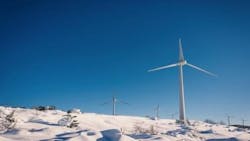Cold Weather Energy Storage System Delivered in Arctic Alaska
Saft has delivered a containerized Battery Energy Storage System with “Cold Temperature Package” on schedule during Q3 2015, to Kotzebue Electric Association, an electric cooperative based in Kotzebue, Alaska.
The system will allow the existing hybrid wind-diesel power system to achieve its full potential, providing cleaner, more reliable and less expensive power to Kotzebue, located above the Arctic Circle in Alaska’s Northwest Arctic Borough (an area the size of Illinois). Kotzebue is not connected to an electrical transmission grid or to any road system, and has historically been dependent on diesel powered generators for electricity. The annual average temperature is 22°F and area residents face some of the highest costs for energy anywhere in the nation.
“Incorporating the Saft Intensium Max+ 20M battery will allow better utilization of our wind system,” said KEA General Manager and CEO Brad Reeve. “Battery storage is an additional tool we need to increase our cooperative's efficiency and reduce our diesel dependence.”
The Saft BESS provides state-of-the-art battery storage technology designed for extreme cold environments. It is the first container system of its kind in North America to utilize the Intensium Max+ 20M product platform. In addition to the battery container, which provides 950kWh and has the ability to operate in environments reaching ambient temperatures of -58°F, the delivered BESS also includes a 1.2MW EssPro Power Conversion System and grid connect transformer, supplied by ABB. The key benefits to the KEA microgrid will be the ability to ride through fluctuations in wind output and to time-shift excess wind energy, providing significant reductions in diesel consumption.
This is Saft’s second project for a remote community above the Arctic Circle. Alaska and other cold temperature regions, where fuel transportation and electricity costs are high, represent a rapidly expanding marketplace for specially-designed battery energy storage systems serving microgrids and other hybrid power systems.
